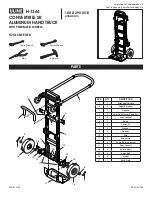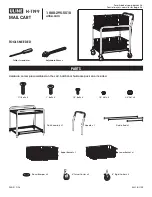
Installation steps (continued):
8.
Level the supports. Adjust glides as necessary. Level 3 supports at a time, if possible. See
Fig. 3 for leveling glide location. See Fig. 7 for leveling detail.
9.
Once entire run of supports is level, fully tighten surface mount anchors.
10. After tightening anchors, check supports for level again. Design of product allows for 1
degree of slope across one section of bench.
11. Apply VHB pads on each support, in location shown in Fig. 9.
12. Install 1/4-20 x 1” set screws in concrete seat sections. Each location has two inserts –
install set screw in proper location depending on intended bench layout. Refer to Fig. 10.
Set aside washers and nuts for installation in future step.
13. Refer to bench layout – install one side of concrete before any accessories. If bench has
any accessories, back side of bench must be installed first. Refer to Fig. 13.
14. Align bottom set screws on concrete in the correct slots on the supports, see Fig. 11. Lift
concrete into bottom set of slots, then rotate up and toward the center of the bench. Use
caution to prevent set screws from scraping or damaging concrete. Once the top set of
set screws is engaged in the slots on the top of the support, slide the concrete outward.
This will engage the top set screws and prevent the concrete from rotating off the
supports. Refer to Figs. 12A and 12B.
15. Install all accessories, including light kits, before installing second side of concrete.
16. For accessories, align brackets on accessory with the correct slots on the T-straps. See
Figs. 14, 15, and 16. Install hardware. Location of accessory (back, arm or surface)
depends on site plans. Refer to Fig. 23 for some configurations that are not possible.
17. For light kit, install bracket onto support. Attach driver plate to bracket, see Fig. 17.
Attach plastic clips to T-straps to secure LED light strips, see Fig. 18. Connect wiring to
line-in wires. Each bench segment requires its own light kit and line-in voltage. Refer to
Fig. 25 for recommended conduit locations
18. Install second concrete seat, see Fig. 19, similar to process in step 14.
19. Install spacer blocks, see Fig. 22. Some block may require a light tap with a dead blow to
install. Use caution to prevent damage to concrete. Tighten snug to concrete, do not
overtighten. Install blocks at every support location. Intermediate support location with a
full perch back installed does not allow for installation of spacer block. If spacer blocks do
not fit in gap between concrete sections, check to make sure that each section is pushed
outward and correctly seated.
20. Remove end cap from each support, see Fig. 20.
21. Install nut and washer (set aside in step 12) on bottom of concrete, up from bottom at
the support, see Fig. 21. The set screw located in the concrete at the top of the section
does not receive a washer/nut. Do not overtighten.
22. Tighten washer and nut on concrete, do not overtighten. Reinstall support end caps.
23. Install optional skatestops, see Fig. 24. Refer to plan drawings for location. Recommend
maximum 36” spacing. Install on clean, dry concrete using Loctite as instructed. Wipe
away excess epoxy before it cures.
Installation Guide
Typology
bench
www.landscapeforms.com Ph: 800.521.2546
ASSEMBLE WITH CARE!
Pangard II
Polyester Powder coat is a strong, long-lasting finish. To protect this finish during assembly, place unwrapped
powder coated parts on packaging foam or other non-marring surface. Do not place or slide powder coated parts on concrete or other hard or textured
surface – this will damage the finish causing rust to occur. Use touch-up paint on any gouges in the finish caused by assembly tools.
Note:
DO NOT DRAG bench across concrete or other rough surfaces. This could damage
the powder coat finish.
Note:
Quantity of bench tops and supports depends on configuration specified. Each
straight segment will have two concrete seat panels. Each small or large radius section
will have one inside concrete seat panel and one outside concrete seat panel. Each
bench segment has two T-straps.
Note:
For Light Kits, line-in voltage is required for each bench segment. Conduit should
be located near the center of the bench, see Fig. 25 for limitations. Driver connects to
intermediate support of each bench segment.
Tools Required
•
Safety glasses
•
Protective padding
•
Necessary equipment/personnel to lift 210 lbs
•
(2) anchors per support, recommended non-corrosive, maximum 3/8-16 diameter, 5”
length, with concrete grip anchors
•
T45 torx driver for attaching T-straps
•
5/32” hex driver for attaching light blocker and spacer blocks
•
3/16” hex driver for attaching accessories
•
Loctite for metal/concrete for attaching skatestops
•
1/8” hex driver for set screw in concrete
•
1/2” wrench for hex nut on concrete
•
1/16” hex driver for removing support cover plate
•
4ft or 8ft level
Date: January 27, 2022
Page 1 of 8
INSTALLATION STEPS:
1.
Assemble wooden template (refer to separate assembly instructions).
2.
Mark holes on concrete according to bench plan drawings, supplied by others.
3.
Drill all holes for entire bench layout, see Fig. 1.
4.
Clear holes of debris.
5.
Install supports, loosely. End supports have one side of casting without holes – this side
faces out, see Fig. 2.
6.
Install ALL T-straps, loosely. T-straps for each bench style can have two different
lengths, refer to notations on Included Components for reference, and Fig. 5A for T-
strap callout location. T-straps must be installed in correct orientation as shown in Fig.
5 if installing multi-segment benches. Once all T-straps are installed, tighten the T-strap
hardware. See Figs. 5 and 6.
7.
Install light blockers on inside of end supports, see Fig. 8.


























